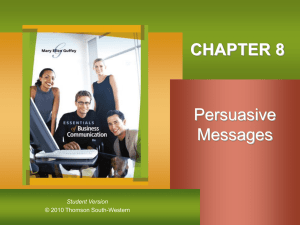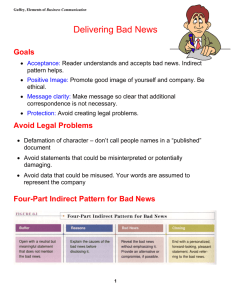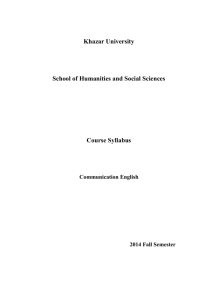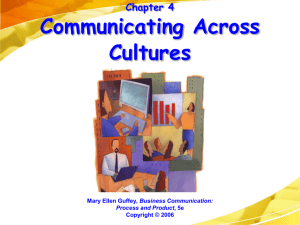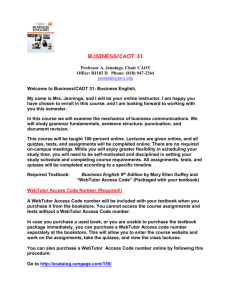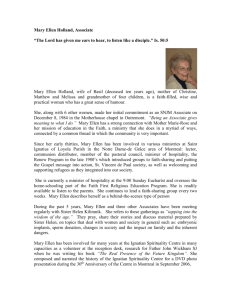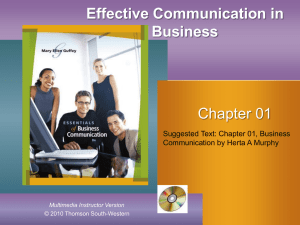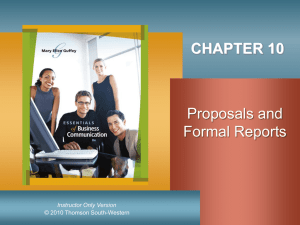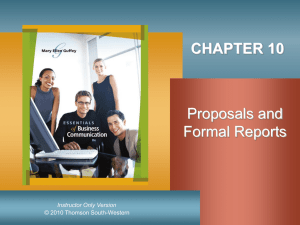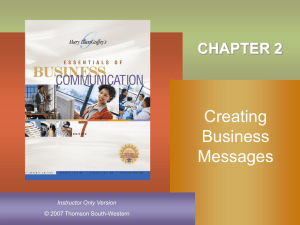Essentials of Business Communication
advertisement
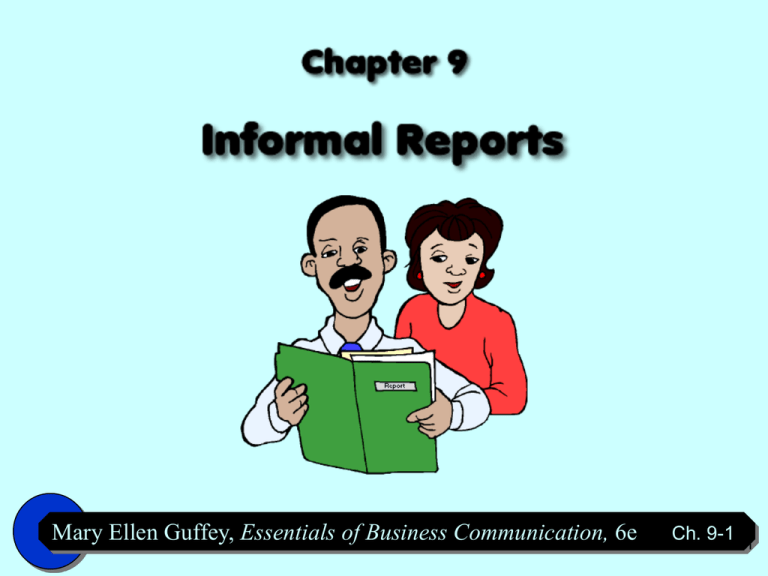
Mary Ellen Guffey, Essentials of Business Communication, 6e Ch. 9-1 1 Six Categories of Informal Reports • • • • • • Information Reports Progress Reports Justification/Recommendation Reports Feasibility Reports Minutes of Meetings Summaries Mary Ellen Guffey, Essentials of Business Communication, 6e Ch. 9-2 Report Formats • Letter format Letterhead stationery. Useful for informal reports sent to outsiders. • Memo format Memo style. Useful for informal reports circulated within organizations. Mary Ellen Guffey, Essentials of Business Communication, 6e Ch. 9-3 Report Formats • Manuscript format Plain paper, manuscript form. Useful for longer, more formal reports. • Prepared forms Standardized forms. Useful for routine activities, such as expense reports. Mary Ellen Guffey, Essentials of Business Communication, 6e Ch. 9-4 General Guidelines for Writing Reports • Define project. • Gather data. • Organize data. • Write first draft. • Edit and revise. Mary Ellen Guffey, Essentials of Business Communication, 6e Ch. 9-5 Where to Gather Data for Reports • Look in company records. • Make personal observations. • Use surveys, questionnaires, and inventories. • Conduct interviews. • Search databases and other electronic resources. Mary Ellen Guffey, Essentials of Business Communication, 6e Ch. 9-6 Organizing Report Data • Indirect Strategy • Direct Strategy • Problem • Problem • Facts • Recommendations • Discussion • Facts • Recommendations • Discussion Mary Ellen Guffey, Essentials of Business Communication, 6e Ch. 9-7 Making Effective Report Headings • Use appropriate heading levels. • Strive for parallel construction. • Use first- and second-level headings for short reports. • Capitalize and underline carefully. • Keep headings short but clear. Mary Ellen Guffey, Essentials of Business Communication, 6e Ch. 9-8 Making Effective Report Headings • Don't enclose headings in quotation marks. • Don't use headings as antecedents for pronouns. For example, avoid: Inserting Hypertext Links. These links . . . . Mary Ellen Guffey, Essentials of Business Communication, 6e Ch. 9-9 Being Objective in Writing Reports • Present both sides of an issue. • Separate fact from opinion. • Be sensitive and moderate in language. • Cite sources carefully. Mary Ellen Guffey, Essentials of Business Communication, 6e Ch. 9-10 Information Reports Introduction • Explain why you are writing. • Describe credibility of data methods and sources. • Provide background. • Identify report purpose. • Offer a preview of the findings. Mary Ellen Guffey, Essentials of Business Communication, 6e Ch. 9-11 Information Reports Findings • Organize chronologically, alphabetically, topically, by importance, or by another method. • Group similar topics together. • Use appropriate headings. Mary Ellen Guffey, Essentials of Business Communication, 6e Ch. 9-12 Information Reports Summary • May include or omit summary. • If included, summarize findings or highlight main points. Mary Ellen Guffey, Essentials of Business Communication, 6e Ch. 9-13 Progress Reports • Describe the purpose and nature of an unusual or nonroutine project. • Provide background information if necessary. • Summarize work already completed. • Describe work currently in progress, including personnel, methods, obstacles, and attempts to remedy obstacles. Mary Ellen Guffey, Essentials of Business Communication, 6e Ch. 9-14 Progress Reports • Forecast future activities in relation to the scheduled completion date. • Include recommendations and requests. Mary Ellen Guffey, Essentials of Business Communication, 6e Ch. 9-15 Justification/Recommendation Reports • Use direct organization for nonsensitive topics and recommendations that will be agreeable to readers. • Identify the problem or the need briefly. • Announce the recommendation, solution, or action concisely and with action verbs. Mary Ellen Guffey, Essentials of Business Communication, 6e Ch. 9-16 Justification/Recommendation Reports • Present a discussion of pros, cons, and costs. • Explain more fully the benefits of the recommendation or steps to be taken to solve the problem. • Conclude with a summary specifying the recommendation and action to be taken. Mary Ellen Guffey, Essentials of Business Communication, 6e Ch. 9-17 Feasibility Reports • Prepare a feasibility report when examining the practicality and advisability of following a course of action. • Announce your decision immediately. • Describe the background and problem necessitating the proposal. • Discuss the benefits of the proposal. Mary Ellen Guffey, Essentials of Business Communication, 6e Ch. 9-18 Feasibility Reports • Describe the problems that may result. • Calculate the costs associated with the proposal, if appropriate. • Show the time frame necessary for implementation of the proposal. Mary Ellen Guffey, Essentials of Business Communication, 6e Ch. 9-19 Meeting Minutes • Include name of the group, the date, the time, the place, the name of the meeting. • List names of attendees and absentees. • Describe disposition of previous minutes. • Record old business, new business, announcements, and reports. • Include the precise wording of motions. Mary Ellen Guffey, Essentials of Business Communication, 6e Ch. 9-20 Meeting Minutes • Record the vote and action taken. • Conclude with the name and signature of the individual recording the minutes. Mary Ellen Guffey, Essentials of Business Communication, 6e Ch. 9-21 Summaries • Compress data from a longer publication, such as a business report, a magazine article, or a book chapter. • Indicate the goal or purpose of the document being summarized. • Highlight the research methods (if appropriate), findings, conclusions, and recommendations. Mary Ellen Guffey, Essentials of Business Communication, 6e Ch. 9-22 Summaries • Omit illustrations, examples, and references. • Organize for readability by including headings and bulleted or enumerated lists. • Include your reactions or an overall evaluation of the document if asked to do so. Mary Ellen Guffey, Essentials of Business Communication, 6e Ch. 9-23 Ten Keys to Designing Better Documents • • • • • Analyze your audience. Choose an appropriate type size. Use a consistent type font. Generally, don't justify right margins. Separate paragraphs and sentences appropriately. Mary Ellen Guffey, Essentials of Business Communication, 6e Ch. 9-24 Ten Keys to Designing Better Documents • • • • • Design readable headlines. Strive for an attractive page layout. Use graphics and clip art with restraint. Avoid amateurish results. Develop expertise with your software program. Mary Ellen Guffey, Essentials of Business Communication, 6e Ch. 9-25 End Mary Ellen Guffey, Essentials of Business Communication, 6e Ch. 9-26 26
